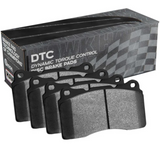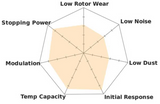Hawk Performance DTC-70
The Hawk DTC-70 race compound was engineered with extremely high torque and highly aggressive initial bite for cars with high deceleration rates, with or without downforce. With superior release and control characteristics, it's a winning race solution on its own or as split friction with DTC-60.
Expert Opinion
DTC-70 is more aggressive than the DTC-60 but has the same temperature range. Many racers of Corvettes, Mustangs, Porsches, BMWs and other specialty race cars choose to run DTC-70 Front and DTC-60 rear. This is not an entry level race compound and should not be driven on the street. Use when you are a serious racer with track experience and have had issues with less aggressive compounds overheating or not providing enough bite.
Hawk Performance DTC-70 Race Compound Characteristics:
- High Performance
- High Torque
- Superior Rotor and Pad Wear
- Excellent Modulation and Release Characteristics
- Applicable to NASCAR, NASCAR modified, ARCA, Super Late models, pavement circle track, Pro 2, Pro 4 Off Road Trucks, Pro Lite, Sports Car, GT, GS, Open Wheel, Formula, Monster Trucks
- Stable Friction Output
- 400-1600 Deg F Operating Temperature Range
- 600-1200 Deg F Optimal Temperature Range
Hawk Brake Pad Installation Procedure
- Install Brake pads properly. Be sure pads are securely positioned in the caliper.
- Flush system with fresh brake fluid.
- Check all hydraulic parts for excess wear and tear.
- Check disc for proper thickness, parallelism, and lateral run-out.
- Check disc for scoring or grooves over .012"" depth. If either applies, resurfacing or replacement is required.
- If disc does not need resurfacing then contamination from the previous brake pads must be removed. Sand discs with Garnet sandpaper using moderate pressure. Use soap and water to clean off disc surface after sanding and machining. Discs should be free and clear of oil, grease, and brake fluid
- Inspect calipers for freedom of movement. Lubricate where necessary
Hawk Brake Pad Bedding Procedure - Motorsports Pads
- After reaching medium speed engage brake pedal to slow car without coming to a complete stop. Release pedal quickly and do not drag brakes. Repeat four or five times.
- At higher speeds engage brake pedal to slow car without coming to a complete stop. Release pedal quickly and do not drag brakes. Repeat five times.
- At or near race speed engage brake pedal to slow car without coming to a complete stop. Release pedal quickly and do not drag brakes. Repeat three times. Allow a few seconds between brake engagements while car is in motion.
- Do not hold brake pedal. Park car for approximately 20 minutes or until brake rotors are completely cool to the touch.
- If during the above steps the brake pedal becomes soft or brake fade is noticed, park the car immediately for approximately 20 minutes. Do not hold brake pedal.
Important Reminders when Burnishing or Bedding Brake Pads
- Do not attempt to use badly worn or damaged rotors with new brake pads.
- Do not drag brakes while car is moving during break-in procedure.
- Do not engage pedal while car is stopped at any time following the break-in procedure.
- Upon completing the procedure, allow the brake system to completely cool before racing.
- Applying the pedal a few times before the start of the race will allow the brake pads to heat up before attempting to reach race speeds.
- li>Clean a used rotor surface with fine sand paper or steel wool, rinse with water, dry and install before bedding new pads
- Some forms of racing do not allow time for the proper break-in procedure to be performed. However, it is still very important to attempt to perform at least the core of the procedure: Build up heat slowly and allow the system to completely cool down before racing if possible.









